| Pages:
1
..
55
56
57
58
59
..
68 |
Microtek
National Hazard
   
Posts: 919
Registered: 23-9-2002
Member Is Offline
Mood: No Mood
|
|
Actually, if it follows either a quadratic or an exponential expression, the larger the charge the MORE is gained by increasing the charge weight (the
curve gets steeper). This may well be counter-intuitive (and rather nonsensical, physically speaking), but there it is.
|
|
|
Fulmen
International Hazard
    
Posts: 1729
Registered: 24-9-2005
Member Is Offline
Mood: Bored
|
|
Not for a shaped charge.
We're not banging rocks together here. We know how to put a man back together.
|
|
|
nitro-genes
International Hazard
    
Posts: 1048
Registered: 5-4-2005
Member Is Offline
|
|
IIRC, shaped charge performance correlates very strongly and linearly with VoD indeed, there should be a graph in PATR somewhere. The non-linerarity
in the LBT model is likely an effect of several phenomena earlier mentioned. One thing is that relatively small charge weights are used, if the
non-linearity is caused by critical diameter, above a certain threshold (like fulmen suggests) there should be no further increase. From the observed
delta observed/expected (linearity from larger test) you might be able to calculate the "missing energy" and calculate back to how much TNT this would
correspond and determine critical diameter. 
The data seems to support a contribution of this effect, since the non-linearity is not observed for MEDINA. Likely, more effects play a role here
though, the cavity volume, explosive volume/weight and density used are probably inseparable factors determining the efficiency by which the
expansion is realized.
[Edited on 6-1-2016 by nitro-genes]
|
|
|
Microtek
National Hazard
   
Posts: 919
Registered: 23-9-2002
Member Is Offline
Mood: No Mood
|
|
You misunderstand. My point is that if you say that the curve follows an (increasing) exponential curve then it follows that at higher values of x,
the relative increase in y increases. It doesn't matter what you are trying to model. The same holds true for a quadratic curve (depending on
sign).
|
|
|
greenlight
National Hazard
   
Posts: 763
Registered: 3-11-2014
Member Is Offline
Mood: Energetic
|
|
New 30 mm EFP attempt with a 16mm steel plate as the target.
Copper liner was used 0.91mm in thickness.
Charge was 18.5 grams of a new batch of PETN plastic explosive.
Standoff was 60cm.
What's unusual is the damage to the plate with not a full circle of copper splashed around the hole like normal. The plate looks like it has been
literally punched through with great force. This time the PE was so dense that the head height was only a little over half the diameter of the charge
so this could be the cause as it would make a wider less pointy projectile. Hole diameter is 17 x 18mm in diameter.
[Edited on 8-1-2016 by greenlight]
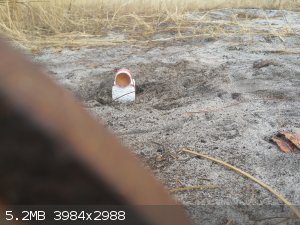 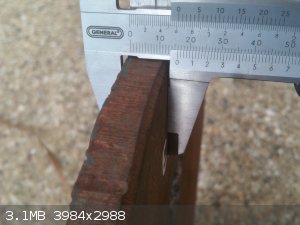 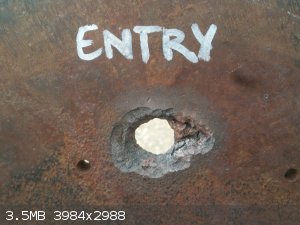 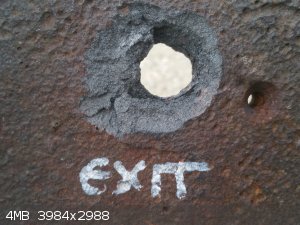
[Edited on 8-1-2016 by greenlight]
|
|
|
nux vomica
Hazard to Others
  
Posts: 267
Registered: 18-7-2013
Member Is Offline
Mood: No Mood
|
|
Nice one as usual greenlight but the fracture and the look of the metal in the hole seems almost like cast iron to me.
In the picture of the calipers showing the thickness is the edge of the plate oxy cut ?
|
|
|
greenlight
National Hazard
   
Posts: 763
Registered: 3-11-2014
Member Is Offline
Mood: Energetic
|
|
Thanks Nux, I am beginning to think it may be cast iron as well..
All of the targets come from a scrap yard so I just grab whatever steel I can find. This stuff looked exactly like steel.
I don't know if it is oxy cut, how do you tell?
[Edited on 8-1-2016 by greenlight]
|
|
|
nux vomica
Hazard to Others
  
Posts: 267
Registered: 18-7-2013
Member Is Offline
Mood: No Mood
|
|
O
I was wondering as you cant oxy cut cast iron this is a m/s oxy cut.

|
|
|
greenlight
National Hazard
   
Posts: 763
Registered: 3-11-2014
Member Is Offline
Mood: Energetic
|
|
Yeah it does have those similar ripples on the outside surface.
I will have a closer look tomorrow in the daytime.
|
|
|
PHILOU Zrealone
International Hazard
    
Posts: 2893
Registered: 20-5-2002
Location: Brussel
Member Is Offline
Mood: Bis-diazo-dinitro-hydroquinonic
|
|
Quote: Originally posted by ecos  |
I am also interested about this effect of adding metal oxides to accelerate the detonation wave inside EM. Do you know any analytical way to calculate
it ? I don't think the patent is mistaken.
|
This effect may be measured accurately with methods to determine VOD:
-with an oscilloscope device, thus electronically;
-or physically with the Dautriche Test Method (a simple geometric system)
See this document.
And this link p72 Explosives 6th edition by Rudolph Meyer, Josef Köhler, Axel Homburg
PH Z (PHILOU Zrealone)
"Physic is all what never works; Chemistry is all what stinks and explodes!"-"Life that deadly disease, sexually transmitted."(W.Allen)
|
|
|
PHILOU Zrealone
International Hazard
    
Posts: 2893
Registered: 20-5-2002
Location: Brussel
Member Is Offline
Mood: Bis-diazo-dinitro-hydroquinonic
|
|
Quote: Originally posted by Fulmen  | | Philou: While that is true it's not relevant to shaped charges. Beyond a certain level more explosives has little impact on the performance, so trying
to calculate the charge from it's performance alone is impossible. |
OK Fulmen, it seems strange to me that it doesn't apply to shaped charges, but I'm open minded   so do you have a reference, graph or document for
me? so do you have a reference, graph or document for
me?
Quote: Originally posted by Fulmen  |
And you'd be wrong. It's closer to an exponential curve, above a certain value you gain nothing from increasing the charge. |
Honnestly, I'm lost, how can it be exponential (or quadratic) and then suddently no more extra energy while increasing the charge? Even for shaped
charge, I can understand that hydrodynamic may give weird effect while scaling up, but this may be "arranged" by changing the angle or the charge
shape.
Quote: Originally posted by Microtek  | | Actually, if it follows either a quadratic or an exponential expression, the larger the charge the MORE is gained by increasing the charge weight (the
curve gets steeper). This may well be counter-intuitive (and rather nonsensical, physically speaking), but there it is. |
Yes that's what I tried to express...maybe that when large charges are used the quadratic or exponential curve looks like linear...
Quote: Originally posted by Microtek  |
You misunderstand. My point is that if you say that the curve follows an (increasing) exponential curve then it follows that at higher values of x,
the relative increase in y increases. It doesn't matter what you are trying to model. The same holds true for a quadratic curve (depending on
sign). |
I'm also confused by Fulmen sentence...
[Edited on 8-1-2016 by PHILOU Zrealone]
PH Z (PHILOU Zrealone)
"Physic is all what never works; Chemistry is all what stinks and explodes!"-"Life that deadly disease, sexually transmitted."(W.Allen)
|
|
|
Microtek
National Hazard
   
Posts: 919
Registered: 23-9-2002
Member Is Offline
Mood: No Mood
|
|
I think we are simply dealing with a case of the mathematical model only being a good fit in a certain region. A simple expression such as a quadratic
or exponential one never model a real-world phenomenon perfectly for all values of the independent variable (since both it and the dependent variable
goes to infinity). Maybe a better model would be something resembling logistical growth, with behavior approaching some limit asymptotically. More
datapoints are required. At any rate, extrapolating beyond the last datapoint is always shaky ground.
|
|
|
Hennig Brand
International Hazard
    
Posts: 1284
Registered: 7-6-2009
Member Is Offline
Mood: No Mood
|
|
Yeah, definitely an inverse curve of some kind if performance is on the y axis.
Edit: I am not a math expert but I guess saying inverse curve is kind of ambiguous if a curve isn't specified first. I am thinking of something like
the upper half of a parabola opening to the right centered on the positive x axis, increasing quickly at first and then tapering off. Yeah, some sort
of exponential curve would seem to be right.
Microtek, I agree and in school I saw that often with the "messier" subjects where complex models with sometimes several (or more) different equations
each one corresponding to a separate range of values were used. The course on heat transfer I took comes to mind and some others.
I am having a little fun with this, feel free to correct me if I am wrong. Fairly easy to see that an explosives ability to do work on a liner
eventually becomes less and less after a certain point with increased explosive mass for a number of reasons. As the liner is accelerated the relative
speed (maybe should say energy level) of the explosive and liner becomes less resulting in less potential for further energy transfer and
progressively less efficiency in energy transfer. Once there is enough explosive to satisfy the optimum/efficient head height requirement (for a
particular diameter) increases in explosive head height/weight result in smaller and smaller increases in explosive pressure and velocity applied to
the liner. Defining what is optimum may be somewhat subjective, but IIRC the point of diminishing return is reached quite quickly for most purposes.
For the ultra high performance shaped charges, I think the sometimes massive charges used have as much to do with ensuring a very even, stable and
guaranteed maximum velocity detonation zone than anything else (not exactly practical devices).
[Edited on 15-1-2016 by Hennig Brand]
"A risk-free world is a very dull world, one from which we are apt to learn little of consequence." -Geerat Vermeij
|
|
|
greenlight
National Hazard
   
Posts: 763
Registered: 3-11-2014
Member Is Offline
Mood: Energetic
|
|
@ Nux, finally got a closeup of the last target plate.
Do you think it is cast iron or oxycut steel?
[Edited on 19-1-2016 by greenlight]
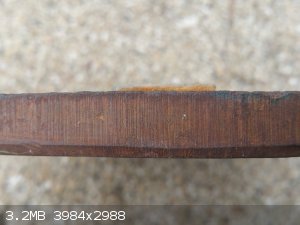
|
|
|
Fulmen
International Hazard
    
Posts: 1729
Registered: 24-9-2005
Member Is Offline
Mood: Bored
|
|
I've kinda lost track of this discussion, but I'm pretty sure I was wrong. Let's start over.
This started with ecos assuming that the explosive charge is proportional to the penetration: http://www.sciencemadness.org/talk/viewthread.php?tid=10575&...
Then PHILOU Zrealone claimed that " the increase of explosion power is quadratic as a function of weight":http://www.sciencemadness.org/talk/viewthread.php?tid=10575&...
There are two ways of looking at this:
1. How charge weight affects penetration for a given liner. Figure 6, page 21 in this document shows the relationship between penetration and explosive height which seems to be logarithmic. But when we look at the explosive
with to diameter ratio (figure 8, p.25) we see a fairly linear relationship. So assuming a fixed explosive height the penetration should follow the
square root of the explosive charge, at least within a limited range. I think it's reasonable to assume that this will also taper off as the ratio
increases.
2. How SC's scale assuming a fixed design. This is much simpler as penetration is proportional to it's diameter while the volume increases with the
cube of the diameter. In other words, to double the penetration you would need to double the diameter but the explosive charge would be 8 times
greater.
[Edited on 19-1-16 by Fulmen]
We're not banging rocks together here. We know how to put a man back together.
|
|
|
Microtek
National Hazard
   
Posts: 919
Registered: 23-9-2002
Member Is Offline
Mood: No Mood
|
|
I'm quite sure that we all more or less agree with this; increasing the explosive height improves performance up to a point, but asymptotically so
(diminishing returns). I was simply nit-picking. Nice find with the attached report by the way.
|
|
|
Fulmen
International Hazard
    
Posts: 1729
Registered: 24-9-2005
Member Is Offline
Mood: Bored
|
|
Nit-picking is fine (I do it all the time), but sometimes it obscures the real issue. In those cases it's usually better to start anew than to figure
out just who said what and why they were wrong.
The data on diameter ratio is interesting, but the range is fairly limited. Nevertheless it would be useful to calculate "explosive efficiency" within
this range, I'll see if I can get around to it tomorrow. I'm pretty swamped with building a new machine shop and moving the equipment, but it would be
a nice distraction from hard labor in freezing conditions.
We're not banging rocks together here. We know how to put a man back together.
|
|
|
nitro-genes
International Hazard
    
Posts: 1048
Registered: 5-4-2005
Member Is Offline
|
|
Regarding the scaling of a fixed geometry shaped charge: What relation would be found when plotting explosive weight against displaced penetration
volume instead of penetration depth? My guess would be that newtons law would still apply, and this would again be fairly linear, in other words... a
CSC twice the size (needing 8 times more explosive, penetrating twice as deep) displace 8 times more volume upon penetration.
[Editted to make question more clear]
[Edited on 20-1-2016 by nitro-genes]
|
|
|
Fulmen
International Hazard
    
Posts: 1729
Registered: 24-9-2005
Member Is Offline
Mood: Bored
|
|
Sorry, I don't understand the question.
We're not banging rocks together here. We know how to put a man back together.
|
|
|
Hennig Brand
International Hazard
    
Posts: 1284
Registered: 7-6-2009
Member Is Offline
Mood: No Mood
|
|
Nitro-genes, assuming equal efficiency, from what I have read I believe you are correct that the relationship between volume of penetration and
explosive weight used is directly proportional (for the same explosive). IIRC in "Fundamentals of Shaped Charges", it is stated that for a given
explosive charge the volume of penetration is the same for the various shaped charges as well as fragmentation type charges. I have always questioned
this, however, because of the different mechanism of penetration between a fragmentation (projectile) and a jetting SC or even a EFP and a jetting SC.
A lot of energy can be put into pushing something at slow speed without causing any penetration, or a very little bit of energy at high speed can be
used to perform a great deal of penetration. I am assuming the differences between the different types of shaped charges and fragmentation charges are
small enough that assuming equal penetration volumes for a given explosive charge is a close enough approximation for most purposes.
"A risk-free world is a very dull world, one from which we are apt to learn little of consequence." -Geerat Vermeij
|
|
|
Fulmen
International Hazard
    
Posts: 1729
Registered: 24-9-2005
Member Is Offline
Mood: Bored
|
|
Nitro-genes: That sounds like a reasonable assumption but I don't have any data on that. At least I can't remember seeing much on hole diameters for
SC's as penetration is usually the main goal.
As for explosive width, it appears that an large-diameter (>1CD) charge increases performance. If you look at the data (http://prod.sandia.gov/techlib/access-control.cgi/1988/88179..., Figure 8 & Table VI)
the 1.42CD charge performed as well as as a conventional SC of the same diameter (explosive width =1CD) but with only 80% of the explosive charge.
This makes sense, with the explosive width equal to the liner diameter the end of the liner will have no explosive charge surrounding it.
We're not banging rocks together here. We know how to put a man back together.
|
|
|
nitro-genes
International Hazard
    
Posts: 1048
Registered: 5-4-2005
Member Is Offline
|
|
Henning, you remember what page that was about the volume displacements in FoSC by any chance? Considering the differences in mass/velocity relation
between an EFP and CSC would seem counter intuitive to have the same volume displacement indeed.
Also target effects are likely different, the jet of a CSC moves so fast, the collision behaves nearly completely fluid, similar to a stream of water
hitting a mudbank as I understand it. Forces are exerted to all sides from the colliding jet tip, like a fluid would, pushing the target material out
of the way and even creates a "backward" stream of liner/target material that is expelled from the formed canal. So not all energy is transferred to
the target and seems different from an EFP impact indeed. Wondered if you would weigh the target before and after firing, how much of the target
material would be gone, though, the liner will also deposit material of course, making this hard to determine.
[Edited on 23-1-2016 by nitro-genes]
|
|
|
greenlight
National Hazard
   
Posts: 763
Registered: 3-11-2014
Member Is Offline
Mood: Energetic
|
|
@Nitro-genes, I think you have the jet behaviour spot on. I was just looking through Intro to technology of Explosives by Paul Cooper and found this:
"The erosion of a target by a penetrating jet is very similar to what one sees when a stream of water from a hose is directed into a bank of dirt.
Material dislodged at the deepest part of the hole turns to mud and flows back along the walls of the hole.
Metal targets under shaped-charge jet attack behave like fluids because the impact velocities of the jet are at several megabar's pressure, well into
the plastic region for almost all materials. This erosion process continues until the entire jet has been used up or the target has been perforated."
I think that this effect would happen to a certain degree with an explosively formed slug contacting and penetrating a steel plate. I have two
picture of an EFP right as it has contacted the steel target. The first shows the initial position of the charge and the first contact with the plate
and the second is right after this moment. The material being thrown back from the impact point must be from the slug and target plate and is a
somewhat similar effect to what is described above.
[Edited on 24-1-2016 by greenlight]

[Edited on 24-1-2016 by greenlight]
[Edited on 24-1-2016 by greenlight]
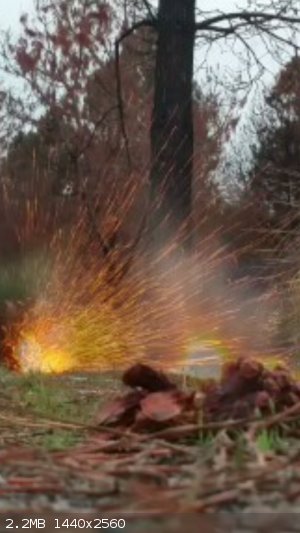
|
|
|
magicchemist
Harmless

Posts: 6
Registered: 24-1-2016
Member Is Offline
Mood: No Mood
|
|
Hi everyone,
I made last week 10gr of plastic (PETN/RDX) with this ratio: 85% HE/10% PIB (from self amalgamating)/5% motor oil (5w40). My plastic is modelable but
it's not like Play doh. It's little bit hard. Someone would have an advise to ameliorate the quality, please ? Thank you very much.

[Edited on 24-1-2016 by magicchemist]
[Edited on 24-1-2016 by magicchemist]
|
|
|
greenlight
National Hazard
   
Posts: 763
Registered: 3-11-2014
Member Is Offline
Mood: Energetic
|
|
Don't know if your question is in the right section but how long did you roll it for?
I have a similar formula myself and roll for 3 to 4 hours to get the density up. It doesn't really matter if its not super soft and moldable.
Commercial semtex is about 20% binder and plasticizer so the softness comes from the extra inerts I suppose.
I used 20% binder/plasticizer once and got it much more moldable but the explosive lost power and didn't perform as effectively in SC.
[Edited on 24-1-2016 by greenlight]
|
|
|
| Pages:
1
..
55
56
57
58
59
..
68 |